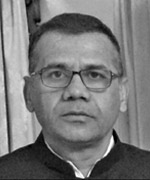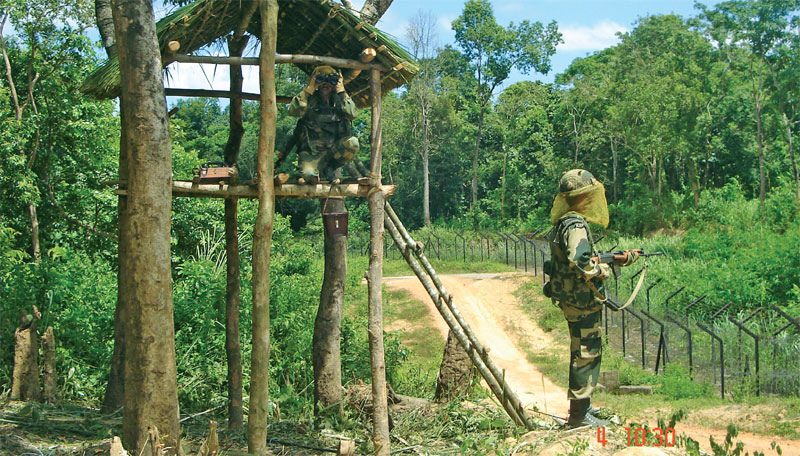BSF should move away from human intensive border guarding practices to technology-intensive means
 R.C. Sharma
R.C. Sharma
The Border Security Force (BSF) was raised on 1 December 1965 to guard the Indo-Pakistan border during peace and assist the army during war. After the 1971 war, East Pakistan became Bangladesh, but the status quo was maintained and the BSF continued to guard the border opposite the new nation. This was the time when the borders were open with limited means of communication. The areas of responsibility were large with huge unmanned gaps. Cross border movement was the norm with friends and relatives on either side of the border. Border guarding was limited to policing in the form of patrol and naka. Smuggling was limited to sneaking in basic needs.
But effective border guarding, and national security are directly proportional to each other. Unfortunately, despite the recognition of this hard reality at the conceptual level, the government did little to strengthen border guarding at the ground level in terms of increasing the strength of the force, modernising the means of communication, improving mobility, and providing modern weapons and equipment. Also, little thought was given to prepare a border guarding doctrine/strategy to guide the BSF as per the strategic goals set for border guarding. Had it been done, there would have been brainstorming to identify immediate and long-term threats that are likely to emerge with changes in the geopolitical scenario at the regional and global levels.
Improvements in border guarding were situational, dictated more by events of the time and existing threats and less through appreciation and long term strategic analysis. Had this been done, attempts to revive militancy in Punjab would have been nipped in the bud and the nation spared the aftershocks that are being felt even today. Terrorism in Punjab was followed by simultaneous militancy and cross border infiltration in J&K, compelling the government to pay attention to border security. Subsequently, more battalions were raised to reduce the gaps in the borders and surveillance was enhanced.
In addition, the concept of fencing was introduced in Punjab to check cross border movement of militants. This was replicated in J&K and the North East, putting a brake on large-scale illegal immigration in the north-eastern states and West Bengal. The threat of terrorism, drugs and weapon smuggling in the east and west also led to the improvement in training regimen and the strengthening of the intelligence grid. The BSF thus played an important and vital role through numerous sacrifices by its officers and men in restoring peace and normalcy in Punjab and J&K.
However, there is still a need to evolve an effective strategy through a mix of conventional and unconventional methodologies and technology to dominate the borders in order to keep all threats to national security at an arm’s length. For these methodologies to be successful there is need to carry out an appreciation of the qualitative requirements of weapons and equipment, infrastructural needs on the border and an analysis of the strengths and weaknesses of adversaries. The adversaries’ weapons, equipment, morale and motivation levels have to be continuously analysed so that we are two steps ahead of them. Had this been done the BSF would have been equipped with modern technological infrastructure to tackle the drone menace. Although the man on the ground has been able to deter the drones through small arms fire, technology could have met the threat more effectively. There would have been revolutionary changes in infrastructure at BOPs, making the lives of the border guards comfortable and raising his morale and motivational levels.

Border Guarding Strategy
Maj. Jeb K Townsend of the US Army in his monograph on ‘Strategy and doctrine: Confusion at a level of war’ says that Carl von Clausewitz, the Prussian general and military theorist, defined strategy as the ‘use of the engagement for the object of the war.’ The key phrase is ‘the use of the engagement.’ By highlighting this point, Clausewitz acknowledged that strategy was tied to the logic of action and not the action itself. He further says that strategy is a logic of action to gain a position of relative advantage against an adversary. This implies that strategy maintain an understanding from which it is to be developed and operationalised. As per the NYU’s School of Professional Studies, ‘A strategy is all about integrating organisational activities and utilising and allocating scarce resources within organisational environment so as to meet the present objectives.’
In simple words, it can be said that border management is a warfare and a warfare needs to have a strategy. Border management strategy needs to have an aim while an aim needs an adversary. Keeping the adversary in mind a strategy needs to be devised, which needs to be logical and justifiable. In the case of the BSF, the adversaries are Pakistan, Bangladesh, visible and invisible internal security challenges faced by border guarding forces day in and day out. To face the border security challenges, the BSF needs a strategic document based on the government policy for management of international borders to ensure territorial integrity. The document will guide commanders in effective and efficient multi-layered border guarding methodology, boosting confidence levels. It will also cater to dynamic border management and future contingencies, giving the force a direction to be more professional and effective.

Strategy Document
What the BSF is executing on the borders is peacetime warfare and there is a need to devise a strategy to fight this warfare. Border warfare is to ensure sovereignty and territorial integrity of international borders and ensure inviolability of the boundary line. Hence, there is a need for strategy on border guarding and border management.
From strategy will flow directions to execute actions on the ground. Actions could be operational or tactical depending upon the level at which they are being executed. What flows from government policy on border management is a strategy document theatre wise to provide strategic directions to the leadership on the ground. Liddel Hart defined strategy as ‘the art of distributing and applying military means to fulfil the ends of policy.’ Thus in border guarding and management, the government’s policy of managing its international borders will enable the leadership to prepare a strategic document on border guarding, from which will flow the methodology to execute actions on the ground. Hence a strategic vision document on border guarding is an essential.
The BSF currently manages the 3,323 km Indo-Pakistan international border spread over J&K, Punjab, Rajasthan and Gujarat and the 4,096 km Indo Bangladesh border spread over West Bengal, Assam, Meghalaya, Tripura and Mizoram. The geographical configuration of different states, demographic distribution and threats affecting economics, demography, social harmony, social integration and territorial integrity vary from state to state and theatre to theatre with intra theatre commonalities existing. There is a need to have a strategy document theatre wise to define the threats, the impact of these threats on national security and broad contours of dealing with these threats. The strategy document needs to define conventional and unconventional methods which the leadership can employ to deal with counterpart threats. The detailed execution methodology will not form part of the strategy document. It will be elaborated through various SOPs and instructions/directions issued region/ theatre wise.

Border Management
Border management calls for cooperation and coordination between different stakeholders. Similarly, a border management strategy needs to encompass all imperatives to make border-guarding effective, efficient and tailored to meet the dynamic challenges of border guarding through a realistic planning process. Before preparing a strategy for border guarding and management, there is a need to carry out a realistic SWOT analysis of the organisation’s requisites along with counterpart requisites to arrive at the strategy. The following essentials need to be considered for incorporation in an action-oriented strategy:
- An in-depth analysis of the geopolitical and geo strategic environment at the regional level to include immediate adversaries and also global geopolitical environment having long term effects on border security and territorial integrity.
- Theatre-specific analysis of the international border along with various states in terms of peculiarities. It must include terrain, demography, ethnic composition both sides of the border, crime and smuggling patterns and various security challenges. Identification of threats theatre-wise like illegal migration, cattle smuggling, infiltration, drugs, arms and FICN smuggling through land and aerial route, tunnelling, radicalisation and indoctrination of youth, riverine/ unfenced area analysis and integration with the army for war time role. In this specific attention needs to be paid to land acquisition challenges in various states and ownership of BOP and bases which effect operational activities.
- Conventional and unconventional ways and means to deal with threats.
- An integrated intelligence plan with effective application of mind to tackle current threats and preparation to deal with future contingencies.
- Methodology for integration with sister agencies and the local police.
- Hinterland border management policy/ strategy assumes enhanced importance with an increase in the BSF’s jurisdiction to 50 km of the international boundary. Border management strategy for different layers of border need elaboration with an in-depth ground and demographic analysis.
- Border protection grid integrating border police ranges and methodology for integration.
- Realistic regular training methodology to combat various security challenges and threats with an enhanced emphasis on physical and mental fitness of men, which slowly were diluted over a period.
- Administration and resource mobilisation for meeting security challenges.
- Identify internal security challenges emanating on an internal security front and strategy to deal with these challenges and force deployment on uncertain borders such as the line of control.
- Human resource essentials and challenges for effective and efficient organisation with high level of satisfaction index and need to lay down pragmatic human resource policy to improve operational and administrative efficiency and effectiveness.
Borders are operationally dynamic. Border guarding is like a warfare that cannot be fought effectively without policy directions and strategy devised from a policy document. 2023 is not 1965. Tactical actions like beat patrolling and naka hold good for policing and do not hold well for dynamic border guarding threats. Though efforts are being made to bring a change in border guarding pattern through minor changes in terminologies, they neither meet the purpose nor make much of an impact on the ground. There is a need to devise new methodology integrating technology to fight present and future border guarding challenges. For that to happen there is need to reduce dependence upon human intensive border guarding and increase reliability on mobility and technology driven border guarding.
The government needs to lay down a policy document detailing its aims for border management and border guarding, which should form the basis for the strategy document for border management. The document clearly needs to lay down response parameters in terms of conventional and unconventional aggressive border guarding. It must reemphasise that an aggressive first line of defence is the need of the hour and national security is dependent on the inviolability of borders. For all this to happen border-guarding forces need to also carry out organisational manpower audits and restructure their organisations to make them more responsive and effective.

